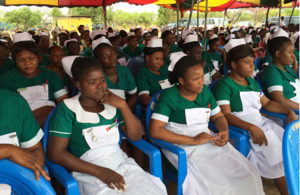Study shows that Ghana may soon have surplus midwives
 Ghana’s health workforce meets only 67 per cent of the number needed for primary health care.
Ghana’s health workforce meets only 67 per cent of the number needed for primary health care.
The country has however achieved 91.3 per cent of midwives required for supervised delivery, a study has revealed.
At the current rate of training midwives, the authors predicted that by 2025, there would be an excess of 7, 170 which would be more than 40 per cent surplus.
Ghana, according to the study, needed at least 221,593 health professionals across 11 categories in primary health care and that the number would grow up to 495,273 by 2035.
The study was published in the Public Library of Science Journal was conducted by three Scientists-Dr. James Avoka Asamani of the World Health Organisation (WHO), Dr. Christmal Dela Christmal and Professor Gerda Reistma, both with the North-West University in South Africa.
“In comparison, the country’s stock of health workers is about 148,390, growing at 5.6 per cent annually.
By 2035, the total number of health workers could reach 333, 770,” part of the publication read.
Using a need-based analysis of the country’s population, disease burden and nationally representative sample to assess the service delivery practices of health workers, the study revealed that the country needed 14,002 midwives but already had 12,786 midwives, 91.3 per cent.
“For doctors, there is a deficit of 7,876 (or 56 per cent shortage), 6,962 shortage of professional general nurses (10.4 percent shortage), 3,226 shortage of medical laboratory scientists (70.4 percent shortage) and 2,941 deficits for pharmacists (73.7 per cent shortage),” another portion of the publication read.
It said for the Community-based Health Planning and Services (CHPS) policy to succeed, there was an urgent need for an additional 17,293 community health nurses which represented a 41.4 percent shortage.
The study concluded that Ghana’s health workforce strategy should endeavour to increase the intake of pharmacy technicians by more than seven fold, general practitioners by 110 per cent, and registered nurses by 55 per cent while midwives training is scaled down by 15 per cent.
It said the country would require $480.39 million investment to ensure adequate training to correct the gaps identified.
In an interview with the Ghana News Agency, Dr. Asamani, the lead author of the study, said the research was the first of its kind to be conducted in Ghana, which employed a population need-based analysis which took account of more than 95 per cent of causes of illness, injuries and risks factors and deaths.
He said the findings were not entirely surprising because it corroborated previous works and evidence that Ghana was closing in on its health workforce needs, but more work needed to be done.
Dr. Christmal said given the fiscal space challenges, the government needed to actively pursue opportunities to export nurses and midwives.
Source: GNA
